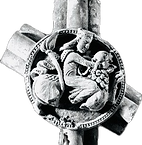
Keynsham & Saltford
Local History Society
Timeline
Keynsham & Saltford History
In 1965, when K&S LHS was first formed, we recognised that there was very little of Keynsham and Saltford's history that had been recorded. Since then some of our members have conducted their own personal research or conducted academic research, which has uncovered more information about Keynsham and Saltford. We have also been fortunate to have received many presentations, from guest speakers, that has also widened our knowledge.
We hope this Timeline page will act as a chronological record of the known history for Keynsham and Saltford. This page will grow, as our knowledge grows. If you notice any inaccuracy or have some information you feel would be useful to be included on our Timeline, please contact us.

Prehistory & the Romans
Prehistory & the Romans
Early humans definitely lived here, first hunting and later farming as early as 500,000 years ago. In the Iron Age, about 2,500 years ago, they built Stantonbury Hill Fort, south of Keynsham, a project involving many people.
St Keyna 490CE
St Keyna is said to have rebuffed the advances of her admirers, preferring to dedicate her time to her religious beliefs and sought permission to serve God in a wooded area now known to be Keynsham. She was warned that the area was full of serpents and was uninhabitable. Legend has it that she ignored the warning and turned the serpents, including snakes and vipers, into stone and she settled in the area.
The stone serpents were of course prehistoric ammonite fossil stones, which can been seen around Keynsham.
St Keyna
490CE
Medieval Period
Medieval Period
We don't know much about the 500 years after the Roman army left. But, for a while, this area was a frontier. The West Saxons, pushing west, threatened the territory of the Britons. This is when the defenders built the Wansdyke ditch.
Later the Saxons built a minster church with burial grounds at Keynsham. For 871CE we find the name of the town first written down as Cawine's hamme. Keynsham Manor was held by the King himself at the time of the Domesday survey of 1086CE. It then passed to William, 2nd Earl of Gloucester, who chose to build an Augustinian Abbey in the memory of his dying 16 year old son, Robert.
22nd March 871CE
Bishop Heahmund was the warrior Bishop of Sherborne who was killed in battle fighting the Vikings at Mardon, Wiltshire. He fought alongside Æthelred, King of Wessex and his brother Alfred who would become King Alfred the Great. According to the chronicler, Æthelweard, Heahmund was buried at Keynsham.
Burial of Bishop Heahmund
Religious Sanctuary
1092
Justyn (believed to have been Lord Morgannwg of Glamorganshire) fled to Keynsham to take religious sanctuary. Suggests the continued presence of a religious establishment at Keynsham.
16th March 1167
Pope Alexander III wrote a letter to Roger, Bishop of Worcester (brother to William 2nd Earl of Gloucester) giving his permission to build the Abbey at Keynsham.
According to the Cardiff Annals, work started in 1169.
Pope Authorises Keynsham Abbey
Keynsham Abbey
1172-1173 - Foundation Ceremony
Keynsham Abbey was officially founded between May 1172 and April 1173. It was established as an Augustinian Abbey, under the Order of St Victor of Paris. The official foundation ceremony was attended by Abbot Richard from St Augustine's at Bristol and Abbot Andrew of Wigmore Abbey, both churches were also from the same Order of Victor.
23rd January 1539
Keynsham Abbey, the abbot and 10 canons surrender to John Tregonwell, principal commissioner for King Henry VIII under the authority of the Act of Supremacy 1534.
Dissolution
Post Dissolution
1539-1685
Following the dissolution, the Bridges family bought the land and were the leading local family until the 1770s. From 1642-49 the Civil War caused great suffering. Locals supported Parliament, but Sir Thomas Bridges was a Royalist. During the conflict the County Bridge at Keynsham was destroyed. In 1685, James, Duke of Monmouth, led the rebellion against James II taking his army to Keynsham. He was defeated at the Battle of Sedgemoor and executed for treason.
1400-1920
From the 1400s, some of our many water mills were used for beating woollen cloth, instead of grinding corn. In the early 1700s, South Mill in Keynsham was making steel and the use of machinery spread. Albert Mill had many uses, lastly for crushing bark to make dyes. Then, in the 1920s, the arrival of the Fry's Chocolate Factory changed the town for ever.